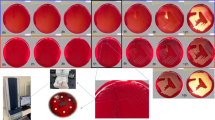Abstract
The susceptibility of 455Escherichia coli blood culture isolate to piperacillin was tested with the disk diffusion test. The presence of different beta-lactamase genes in these strains was also studied using DNA hybridization. Of the TEM beta-lactamase producing isolates, 64 % (61/95) were interpreted as intermediately susceptible to piperacillin. Because piperacillin is hydrolyzed by TEM-type beta-lactamases, we suggest that the intermediate susceptibility category should be reduced or omitted in testing piperacillin susceptibility ofEscherichia coli isolates.
Similar content being viewed by others
References
Olsson-Liljequist B, Dornbusch K, and the referensgruppen för antibiotikafrågor: Resistensbestämning av bakterier mot antibiotika. Referens- och Metodbok. Stockholm, 1990.
National Committee for Clinical Laboratory Standards Performance standards for antimicrobial disk susceptibility tests. M2-A4. NCCLS, Villanova, PA, 1990.
Medeiros AA, Jacoby GA Beta-lactamase mediated resistance. In: Queener SF, Webber JA, Queener SW (ed): Beta-lactam antibiotics for clinical use. Marcel Dekker, New York, 1986, p. 49–84.
Huovinen P, Herva E, Katila M-L, Klossner M-L, Renkonen O-V, Toivanen P Reliability of disk diffusion method using semiconfluent growth in the determination of aminoglycoside resistance. Acta Pathologica Microbiologica and Immunologica Scandinavica (B) 1986, 94: 153–157.
Huovinen S, Huovinen P, Jacoby GA Detection of plasmid-mediated beta-lactamases with DNA probes. Antimicrobial Agents and Chemotherapy 1988, 32: 175–179.
Feinberg AP, Vogelstein B A technique for radiolabeling DNA restriction endonuclease fragments to high specific activity. Analytical Biochemistry 1983, 132: 6–13.
Huovinen S Plasmid-mediated β-lactamase resistance in gram-negative bacilli. Detection of β-lactamases by using DNA-hybridization and isoelectric focusing. Thesis. Turku University, Turku, 1988, p. 1–66.
Jacoby GA, Sutton L Beta-lactamases and beta-lactam resistance inEscherichia coli. Antimicrobial Agents and Chemotherapy 1985, 28: 703–705.
Gerlach BA, Wiedemann B Tn3 as the molecular basis of ampicillin resistance inE. coli — an epidemiological study. Zentralblatt für Bakteriologie, Mikrobiologie und Hygiene (A) 1985, 260: 139–150.
Philippon A, Labia R, Jacoby GA Extended-spectrum beta-lactamases. Antimicrobial Agents and Chemotherapy 1989, 33: 1131–1136.
Cooksey R, Swenson J, Clark N, Gay E, Thornsberry C Patterns and mechanisms of beta-lactam resistance among isolates ofEscherichia coli from hospitals in the United States. Antimicrobial Agents and Chemotherapy 1990, 34: 739–745.
Author information
Authors and Affiliations
Rights and permissions
About this article
Cite this article
Arstila, T., Huovinen, S. & Huovinen, P. Problems in interpretation of piperacillin susceptibility of TEM-1 producingEscherichia coli in the disk diffusion test. Eur. J. Clin. Microbiol. Infect. Dis. 10, 1066–1067 (1991). https://doi.org/10.1007/BF01984931
Issue Date:
DOI: https://doi.org/10.1007/BF01984931




